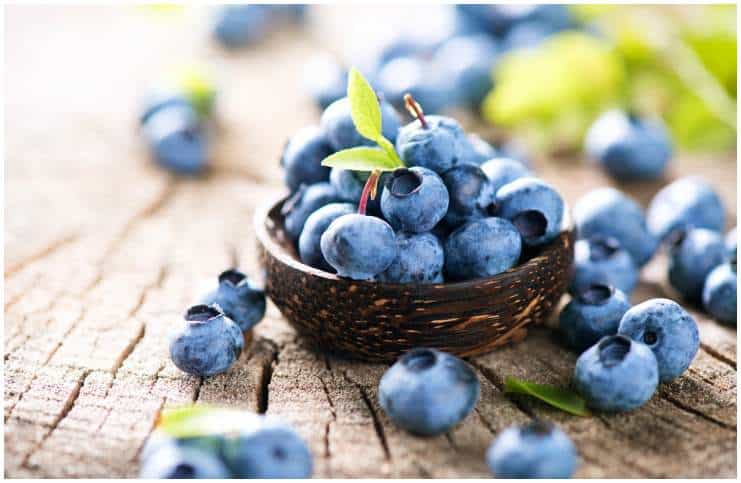List of Foods High in Resveratrol – The Natural Source of Longevity:
Resveratrol, 3,5,4′-trihydroxy-trans-stilbene, is a powerful antioxidant produced by some plants to protect them against environmental stresses, such as injury, or when the plant is under attack by pathogens, such as fungi or bacteria.
It is usually referred to as „the fountain of youth” due to its wide-ranging health benefits. More than 600 scientific researchers have found beneficial effects, covering more than 340 different diseases.
In broad strokes, this antioxidant has been found to exert the following functions and actions: anti-infective, broad-spectrum antimicrobial, antioxidant, cardioprotective, and neuroprotective.
Food sources include – grapes, raspberries, blueberries, mulberries, cocoa, peanuts and much more. It is also available in supplement liquids and pills, in which it is sometimes combined with vitamins or other ingredients.
Health Benefits of Resveratrol
Blood Pressure
A small and brief randomized, double-blind, cross-over study in the November 2011 issue of Cell Metabolism established that 150 mg of resveratrol once daily for 30 days considerably lowered arterial blood pressure, plasma glucose, and insulin concentrations, tumor necrosis factor (a marker of inflammation) and plasma triglyceride concentrations, among other findings.
It also shares a lot of beneficial effects with many bioflavonoids, such as reducing the occurrence of osteoporosis, and may provide more effective protection than other well-known antioxidants, such as vitamins E and C.
Anti-aging Effect
Studies in laboratory mice have found increased survival and lower incidence of several diseases and conditions connected with aging, but the results are contradictory.
Protective effects have been found in mice fed a high-fat or a low-calorie diet, but one study found that mice fed a standard diet beginning at the age of twelve months did not live longer. In 2009, after reviewing the animal studies, the highly respected Medical Letter concluded:
“The antioxidant appears to produce some of the same effects as calorie-restricted diets that have reduced the incidence of age-related diseases in animals. Whether it has any benefit in humans remains to be established.”
Lowers Inflammations
A study from 2010 concluded that this antioxidant suppresses inflammatory effects in certain brain cells (astrocytes and microglia) by inhibiting different pro-inflammatory cytokines and key signaling molecules.
Improves Memory
Another study published by a faculty member in the Texas A&M Health Science Center College of Medicine reveals that the antioxidants may help prevent age-related decline in memory. The study suggests that it may have positive effects on the hippocampus, an area of the brain responsible for carrying out critical functions such as memory, learning, and mood.
Top Foods High In Resveratrol
Japanese Knotweed
Japanese knotweed is an invasive species, yet it has been used traditionally in Japanese and Chinese medicine for its benefits on circulatory and gastrointestinal health. In addition, the plant is an excellent source of resveratrol, with concentrations of up to 377mg/100g.
Grapes and Wine
In grapes, it is found primarily in the skin, but also in the seeds. The amount found in grape skins also varies with the grape cultivar, exposure to fungal infection, and its geographic origin.
The amount of fermentation time a wine spends in contact with grape skins is an important determinant of its antioxidant content.
Grapes grown in humid environments tend to have more antioxidants than grapes grown in more arid environments.
The theory behind this phenomenon is that grapes grown in humid environments produce more antioxidants in order to fight damaging fungus. Muscadine grapes actually have the highest concentration of it in nature because of their extra thick skins and many seeds where it is concentrated.
Red wines contain (per 5-oz glass) 0.03-1.07 mg, and white wines 0.01-0.27 mg. Red grape juice contains 0.017-1.30 mg per 5 oz.
Peanuts
Peanuts are an excellent source of antioxidants. An ounce of peanuts contains about the same amount of resveratrol as almost two pounds of grapes.
Whether your goal is better overall health or weight loss, there are some compelling arguments for including peanuts in your diet on a nearly daily basis.
Blueberries and Bilberries
Blueberries have about twice as many antioxidants as bilberries, but there is great regional variation. These fruits have less than 10% of the antioxidants of grapes. Heat processing or cooking of these berries will contribute to the degradation of antioxidants, reducing it by up to half.
Cocoa, cacao, chocolate
A study published in the September 2008 issue of the Journal of Agriculture and Food Chemistry disclosed that the levels of the antioxidants found in cacao and chocolate products are second only to red wine among known sources of antioxidants.
Gram for gram, the cocoa powder had the highest average amount of antioxidants, followed by dark chocolates, baking chocolates, semi-sweet chips, milk chocolate, and chocolate syrup.
Red cabbage, red onion, and other purple foods
The purple pigment in all of these vegetables and fruits contains flavonoids, including this natural antioxidant.



This article helped me figure out how I never seem to catch a cold or the flu and majority of the things listed I love to eat, and who doesn’t like a nice glass of red wine